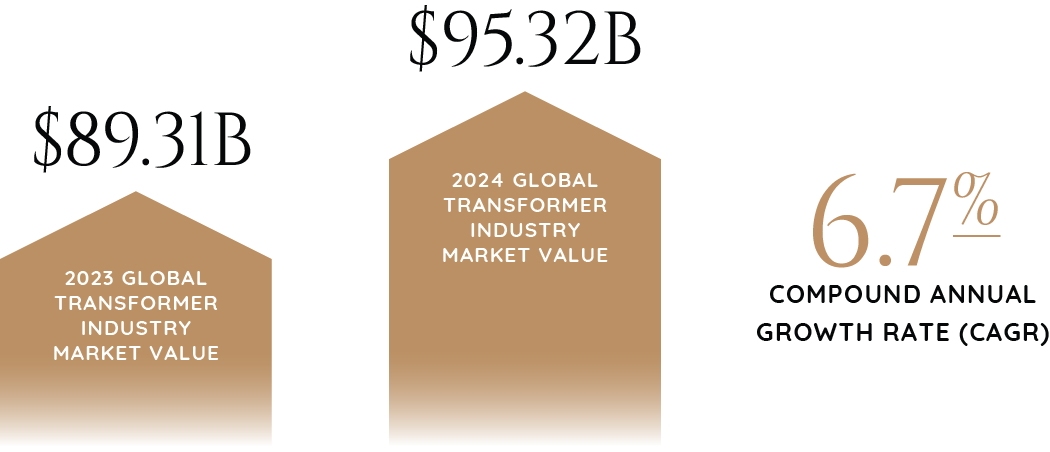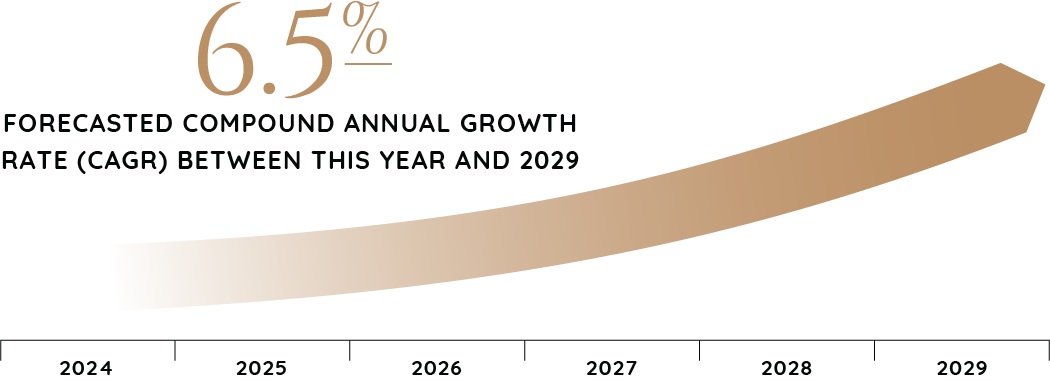A vital segment of the energy and power industry, the global transformer industry grew at a compound annual growth rate (CAGR) of 6.7% from $89.31 billion in 2023 to $95.32 billion in 2024. The sector is on pace with a CAGR of more than 6.5% between this year and 2029.
This growth can be attributed to a wide range of transformative factors, including:
- Power infrastructure development
- Industrialization
- Urbanization
- Grid expansion and upgrades, including smart grid deployments
- Renewable energy integration
- Government initiatives and regulations
- Energy storage integration
- Upgrades to higher voltage levels
- Resilience and grid stability concerns

About Transformers
Transformers are essential electrical devices that move energy between circuits through a process known as electromagnetic induction. They make power accessible as it travels from a power utility to a home or business across long distances. Transformers can increase or decrease voltage and current levels. They can also isolate circuits, increase or decrease capacitor value, and prevent a direct current from passing between two circuits. In grid networks, there are two main types of transformers: power and distribution.
Segmentation
- By Transformer Type: Power Transformer, Distribution Transformer
- By Type: Low-Rated Transformer, High-Rated Transformer
- By Phase: Single-Phase, Three-Phase. The three-phase segment is forecast to grow at a significant rate through 2032.
- By Application: Residential and Commercial, Utility, Industrial. The industrial segment is forecast to dominate the market through 2032.
- By Insulation: Dry, Liquid-Immersed
- By Cooling Type: Air-Cooled, Oil-Cooled. In 2022, the air-cooled segment contributed more than 80% of the market share.

Distribution transformers are expected to continue to dominate the market. These transformers carry out the final voltage transition in the electrical power distribution system and are used to lower the voltage of the distribution lines. In many countries, expanding electricity transmission initiatives and distribution projects have steadily increased transformer capacity. These developments strongly favor surging market growth for distribution transformers in the future.
Trends and Growth Drivers
Among the most significant trends in the transformer sector are the development of superconducting transformers for efficiency, collaboration for standardization and interoperability, investments in transformer upgrades and modernization, the use of advanced cooling systems, and the expansion of medium—and low-voltage transformer markets.
Favorable government policies that aim to increase electrification will continue contributing to the market's growth. Several countries are implementing various initiatives to increase electrification and improve renewable energy infrastructure in rural areas. These types of policies will continue to drive the market.
Your perfect buyer is out there, find them today.
The increasing demand for electric vehicles (EVs) is also driving the growth of the transformer market. This is because the charging stations needed for these cars are connected to the grid, which requires transformers to power them.
As the energy landscape evolves, there is an increase in the need for intelligent transformers and an expanded role of artificial intelligence (AI) in grid optimization. The market is shifting towards the use of independent and self-regulating intelligent transformers. These transformers are programmed to regulate voltage and maintain contact with users while providing much-needed information and feedback on the power supply. They can gauge the power needed and react to fluctuations through voltage optimization. Smart transformers significantly reduce greenhouse gas emissions and power consumption because they can always supply electrical equipment with the ideal amount of power.

By Region
The Asia-Pacific region was the largest in the transformer market in 2023. In recent years, many Asian countries have seen continued growth in power distribution networks to offer access to more rural communities and expand existing power infrastructure in semi-urban regions. The nations that currently have the highest demand for power are China and India. Asia-Pacific is expected to hold the highest share of the global transformer market.
M&A
The global transformer market is very competitive, as several leading and emerging players vie for market share through technological innovation, product quality, and cost efficiency. Strategic partnerships are becoming more in demand as there is a growing push for smart grid solutions and eco-friendly products. Mergers and acquisitions enable companies to improve their capabilities and global reach as regional dynamics and regulations shape core strategies. Strategic M&A is also used to build economies of scale, acquire talent, and gain access to new customers and markets. Increasing collaboration in the industry is one of the major factors expected to provide significant potential for market growth.
Additionally, as the world shifts towards eco-friendly transformers amid growing environmental concerns, vital competitive factors include technological developments, pricing tactics, and geographical outreach. Adherence to increasing government regulations drives investment in sustainable solutions to profitably meet the world's evolving demands. M&A strategies are playing a pivotal role in accomplishing these ever-evolving objectives.
Categories
Get These Insights Delivered Directly To Your Email
Explore our curated collection today and stay ahead of the curve in M&A.
